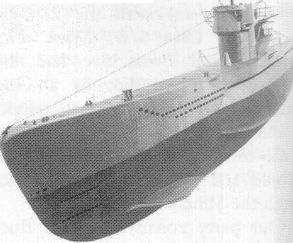- Author
- Whitehouse, John
- Subjects
- WWII operations
- Tags
-
- RAN Ships
- None noted.
- Publication
- September 2002 edition of the Naval Historical Review (all rights reserved)
U.1009 was a Type VIIC, the standard operational U Boat, and although there were bigger, faster boats at sea at the time these were comparatively few in number. U.1009 was based in Norway from whence she had taken part in some operational patrols in search of the convoys going to, or returning from, North Russia but apart from these, and a few training outings in the Baltic, she was not vastly experienced – as a single ship’s company that is to say; some individual officers and ratings had more sea-time than the boat itself Now she was surrendering.

HMS BYRON AND U.1009 met at Loch Eriboll on 9th May 1945 – Byron having spent the previous day coming north through the Minches, and U.1009 coming south from Trondheim – and being attacked on the way, by mistake, by aircraft of Coastal Command.
Preparation and Excess Baggage
We in Byron spent a busy evening being told we were to provide boarding parties; several matters arose. First, as the Royal Navy was to appear in plain view of the enemy, we were to board wearing our best No. 1 blue serge uniform. Now, it is only possible to do a limited number of things in a sailor’s uniform, and boarding a potentially hostile submarine, even in a flat calm, is not one of them. Then Able Seaman Day let it be known that he only put on his No. 1’s – with the tiddly U front and the flamboyant cap tally bow – for the benefit of His Party, and only then on the understanding that she would be agreeable to certain simple requests, but that this degree of cooperation did not extend to the Germans. The matter of uniform did not end there. It quickly became apparent that we were to take with us a good deal of gear – fraternization with the Germans was forbidden so we had cardboard boxes of Field Rations, cardboard boxes of thermos flasks, Lanchester sub-machine guns (a posh version of the Sten) which none of us had ever seen before, signal flags, Aldis lamps, lengths of chain (unexplained at this stage) and finally we were to – with the help of inks and coloured pencils supplied by the ship’s office and the chart room – manufacture some German naval ensigns in order to fly them beneath the White Ensign; all of this was to be stowed away in a uniform devoid of pockets and requiring a minimum of five hands. (We solved the problem in the only practicable way – by asking a German rating to hold a few things, such as the Lanchester, whilst we climbed through hatches and the like. The U Boat Service was catered for to Cordon Bleu standards which the German crews, with the true brotherhood of the sea, asked us to share; and that disposed of the cardboard box problem).
My own suggestion, that to take home-made German naval ensigns aboard a German warship was a bit like carrying coals to Newcastle, was dismissed as the ravings of someone who was Under Age anyway and who had been obliged to celebrate VE Day in lime juice. That problem also was solved by the first wave that came over the conning tower and reduced our artistic efforts to a soggy mush of every colour of the rainbow.
The Brief
Having seen the end of the excess baggage problem and having got ourselves successfully victualled-in with the Deutsche Kriegsmarine we could turn our attention to less immediate matters. Our brief was to look for Scapa Flow type scuttling charges (we worked on the principle that if a German rating was nearby, he was not likely to be standing on a bomb), ditch the torpedo warhead pistols, and get them to throw the anti-aircraft gun barrels over the side, and to round up any documents, instruments (like typewriters, I was told knowingly, the significance of which was completely lost on me) and anything else that looked interesting. What looked interesting to us were the German all-weather wet suits (grey leather trousers and jackets with a huge sou’wester), cigars (which turned out to be cardboard tubes filled with tobacco dust and therefore a considerable disappointment), binoculars, and anything which might fall into less deserving hands once the crews had taken their personal property ashore and the boats came under the care of shore-based barrack stanchions. There was a considerable stock of German wine which we ignored, as we considered it fell into the port and lemon category and therefore fit only for elderly tarts in dockside boozers.




